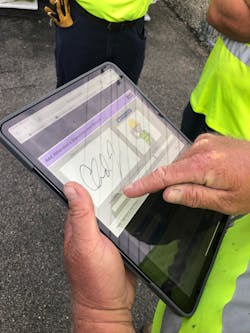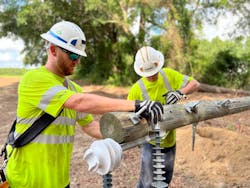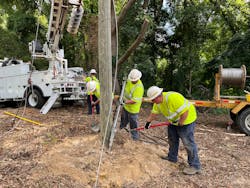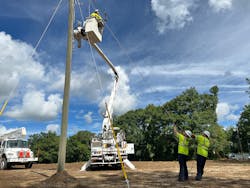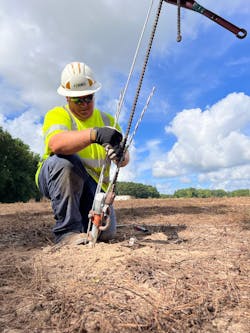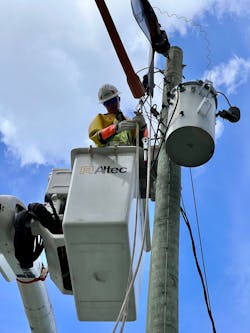Small change. Meaningful impact. It is a simple description, but one that perfectly describes a recent implementation at Jones-Onslow Electric Membership Corporation (JOEMC). For this forward-thinking electric cooperative, it was an important step toward streamlining its safety program and bolstering critical requirements.
Like most electric coops, JOEMC ties back to the early days of rural electrification. Located in the southeastern part of North Carolina, U.S., where it hugs portions of the Atlantic coastline, JOEMC currently serves just under 80,000 members across six counties: Jones, Onslow, Duplin, Lenoir, Pender and Craven.
While this co-op hails from simple beginnings, it has not remained tethered to the status quo. It has embraced the implementation of advanced technologies such as advanced metering infrastructure (AMI), is in the process of implementing advanced distribution management system (ADMS), and will implement a meter data management system (MDMS) in 2023-2024. With an unwillingness to remain static, it continues to press forward, seeking opportunities to use emerging technologies to increase reliability, improve efficiency and, of course, maximize safety.
One Small Step
The co-op’s electric infrastructure includes 2400 miles (3862 km) of distribution lines, fed by 76 miles (122 km) of transmission lines. JOEMC takes transmission delivery from Duke Energy Corp. to feed its transmission and substation network, which supplies 32 distribution substations.
Given the scope of its operations, JOEMC runs lean, employing 183 people, approximately 90 of whom account for outside line workers who handle myriad tasks, including vegetation management and line construction and maintenance. To ensure substations are carefully managed, the co-op employs a substation supervisor who oversees two substation crew leaders, each managing three line workers with expertise ranging from apprentice to journeyman. These line workers rotate annually, with each three-person crew returning to general operations following their year-long assignment.
In 2019, JOEMC began streamlining its operations, implementing robust software applications to make operational processes nimbler and more proactive.
Initially, leadership at the co-op focused those efforts on substation inspections, selecting MinMax Technologies’ eSMART electric system maintenance and asset reliability tracking solution to accomplish its goals. Following the success of this first program implementation, the utility expanded its use of the cloud-based platform to include facility and safety inspections.
While JOEMC now had electronic solutions that modernized the care and oversight of critical functions, the ongoing process of job briefings still seemed stuck in inefficiency.
JOEMC’s leadership wanted to move beyond its outdated methods — printed forms stored in three-ring binders and filing cabinets — where management of files and tracking was difficult. However, with other needs taking priority, finding improved ways to complete job briefings took a back seat. That is, until 2020, when MinMax developed a job briefing module for the eSMART system.
The Need for Change
Safety remains top of mind in the utility industry, and mandates from different levels — internal and external — are required to protect employees. This focus on safety, coupled with a desire for efficiency, prompted JOEMC to consider a new way of completing an old routine with Occupational Safety and Health Administration (OSHA) job briefings.
Job briefings can become rote. And while they might be only one small component of an overall safety program, inattention to these mandates carries significant consequences when overlooked or perhaps flippantly applied. While it might seem like a small step, or perhaps only a minor improvement, OSHA compliance impacts safety and a utility’s bottom line. Thus, it is essential to consider because compliance with OSHA safety standards applies regardless of meter count, workforce availability or employee preference.
Where noncompliance leads to injury or a casualty, the liability to employers can encompass financial, legal and reputational damage, not to mention the emotional turmoil and devastation it can create internally. Ensuring compliance with OSHA standards protects both employees and the organization. According to the 2022 Workplace Safety Index, “The top 10 causes of workplace injuries cost U.S. businesses more than $1 billion a week, with total injuries costing more than $58 billion every year.” In the electric utility space, line crews, in particular, face many of those potential hazards on a daily basis.
While that cost to business is high, it only scratches the surface of the total cost. To include the indirect costs of injuries and illness, including “training replacement employees, accident investigation and implementation of corrective measures, lost productivity, repairs of damaged equipment and property, and costs associated with lower employee morale and absenteeism,” adds a significant financial burden, according to OSHA.
When presented with an opportunity to streamline the job briefing process, leaders at JOEMC responded with an easy “Yes,” and signed up to become a test user of MinMax’s job briefing module.
Like Them Or Not
While job briefings might not be a line worker’s favorite part of the job, most recognize its role in mitigating risk, a necessary step in ensuring employees understand the scope of a project — complicated or not. However, it is critical to remember and remind employees the importance of the job briefing is not about completing the required paperwork; the importance comes from properly discussing the hazards or potential hazards of completing the required work.
For example, crews easily recognize the risks associated with electricity, but sometimes traffic control, or lack thereof, presents the most significant hazard. When a construction zone does not have proper safety procedures in place, multiple hazards exist, including traffic accidents resulting from distracted drivers, which unfortunately can yield tragic results.
Quick, Not Rushed
Because JOEMC had prior experience using the eSMART software, adding the job briefing module was a relatively simple expansion. Initially, the coop focused on digitizing two safety briefs — general job brief and substation job brief — and had substation crews field-test the new module.
The substation supervisor was a crucial resource in this process and worked closely with the co-op’s engineers throughout the implementation process. Also critical to the transition was the utility’s safety manager, who ensured the system was a good fit for the existing safety program. However, the time between deciding to test the new module and having it ready for field use spanned only a few days, as engineers at JOEMC used the eSMART system
templates to quickly create digital versions of the old paper copies.
In the field, each job briefing takes approximately five to 15 minutes to complete using iPads. Completion time varies based on the complexity of each job. To complete a briefing, a person navigates to the job briefing tab in the eSMART application and selects new job briefing. From there, they choose the appropriate briefing type and answer the questions. After completing all questions, each crew member then signs the form, acknowledging the job briefing was discussed before work began. Employees can select to have completed briefs emailed to them.These new electronic forms make it easy for crews to stay current and compliant as jobs progress, since briefings can be revisited throughout the day as locations change and new sign-offs are needed.
Every user can complete a job briefing, and system editors can create new job briefings based on the organization’s changing needs. A notes section provides space to add detailed steps, where needed, to identify hazards before any work occurs. Currently, JOEMC has 123 users set up to use the module. Each week, they conduct 100 to 120 job briefings on average. In an annual snapshot spanning 2021-2022, JOEMC completed 4454 job briefings using the new module. In total, the co-op has completed 6000 job briefings electronically since its initial implementation in January 2020.
Using the job briefing module in the eSMART platform enabled JOEMC not only to store the information but also to track its effectiveness. Maintaining all completed forms has been effortless, as they are stored in the cloud that MinMax hosts.
Take It Easy
Overall, the transition was well received by employees. Were there bumps in the road? A few.
With a diverse workforce comes diversity of opinion, particularly regarding technology. While some employees are quick to embrace change, others prefer doing things the way they have always been done.
Like other utilities implementing new technology, JOEMC faced those same employee hurdles. However, it is important to note co-op leadership never forced the issue, instead taking a slow and measured approach before considering a wide-scale rollout. Doing so gave the co-op the time needed to build a level of comfort and internal support among end users.
Of course, JOEMC did have familiarity on its side. Because line crews rotate yearly through the substation program — where the eSMART asset management software solution had been used for monthly substation inspections since 2019 — many already were comfortable using the software.
JOEMC made the job briefing module available to other departments within operations only after it had buy-in from that initial group of users; currently, its use is department wide.
Adaptability
Overall, JOEMC found the job briefing module easy to incorporate and modify. While the process of job briefings is unchanging, the needs and hazards found in the field often are fluid. The ability to easily access and modify forms in real time adds an essential layer of transparency and safety.
When crews see a new hazard, they can quickly edit existing briefs, making them readily available for individual signatures. Each form can be updated as many times as needed and signed by existing or newly added workers to the job. The ability to customize is critical and was an important feature in JOEMC’s decision to use the module.
Where To Go From Here?
JOEMC sees opportunities for expansion in three distinct areas:
- Personnel
- Increased customization
- Training.
In the past, the coop used the expertise of its on-staff electrical engineers — there were two — for jobs, such as programming and installing relays, that exceeded the technical knowledge and skill of the existing substation crews. However, as the utility continued to grow, so did the need for additional technical support. It hired two additional electrical engineers and will be hiring an engineering technician in the future to support the programming and installation of relays as well as assist in the maintenance of future ADMS that rely on network connectivity.
The job briefing module enables utility leaders to create job-specific briefings or general briefings, but the customization is limitless. Therefore, one idea for the future includes developing both job-specific and hazard-specific job briefs. Currently, forms are very similar, so adding specificity around the hazards crew members might experience will increase efficiency and bring important visibility to safety discussions. Likewise, job-specific job briefing forms — for example, recloser changeouts/bypassing, regulator changeouts/bypassing, pole changeouts, transformer changeouts, underground construction, overhead construction and vegetation management — will reduce the time each briefing takes to complete, which is a frequently voiced frustration from the field. JOEMC also has a preconstruction checklist in the works, which it hopes to roll out this fall.
Lastly, co-op leaders believe adding specificity to the job briefing process will provide them with an invaluable resource for training new employees on hazard recognition.
Benefits Gained
While the JOEMC leadership team recognizes the importance of staying proactive in an ever-changing electric landscape, decisions are not made haphazardly or without thoughtful discussion and analysis. The co-op’s expanded use of existing asset management software required minimal investment yet yielded meaningful results, most notably in personnel efficiency and effectiveness, transparency into system and safety reporting, and improved compliance.
From an operational perspective, switching to an electronic job briefing added visibility to the quantity and magnitude of the work line crews complete daily. And while employees work hard to avoid accidents, accidents do happen. However, with robust reporting features and a cloud-based application, JOEMC recognizes the important benefit of being able to quickly access and extract job briefing records in the event of an accident.
Gone are the days of sending someone to the filing cabinet to search for a paper copy. Now, if an emergency occurs, any employee with access to the system can log in to see who signed the job briefing, what was covered during the briefing and who was authorized to be on the job site. All this information is stored each time a job briefing is completed.
JOEMC embarked on this journey to build operational efficiency by streamlining a critical aspect of its safety program. Supported by a knowledgeable and helpful vendor, the utility easily improved the process of completing job briefings across its organization. The result: increased operational transparency, enhanced pre-job safety discussions and a more effective workforce.
William T. Jones III, P.E. ([email protected]) received his BSEE degree from North Carolina State University and is a licensed professional engineer in North
Carolina. He joined Jones-Onslow Electric Membership Corporation in 2018 and currently serves as its engineering services manager. In this position, Jones helps to lead planning and design functions at the electric cooperative, including long-range planning, construction work plan, project development and system modeling.
For More Information
Jones-Onslow EMC | www.joemc.com
MinMax Technologies | www.minmaxtech.com
William T. Jones III
William T. Jones III, P.E. ([email protected]) received his BSEE degree from North Carolina State University and is a licensed professional engineer in North Carolina. He joined Jones-Onslow Electric Membership Corporation in 2018 and currently serves as its engineering services manager. In this position, Jones helps to lead planning and design functions at the electric cooperative, including long-range planning, construction work plan, project development and system modeling.

